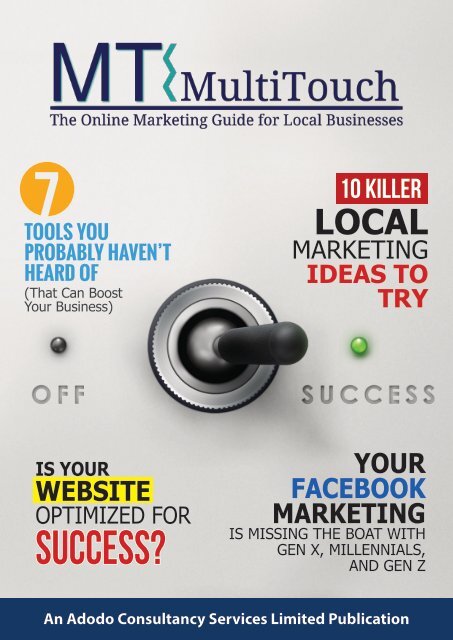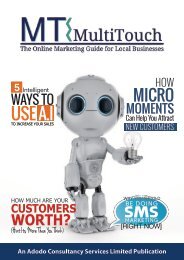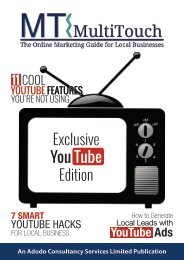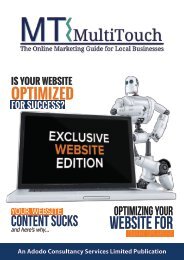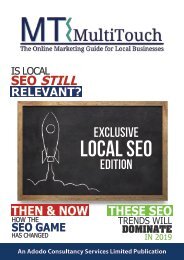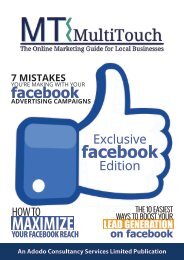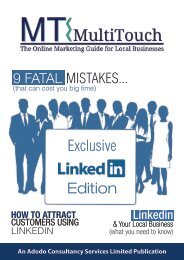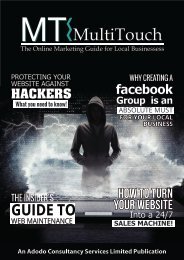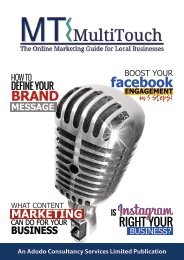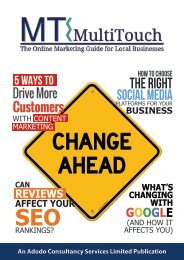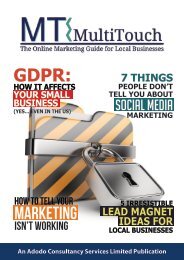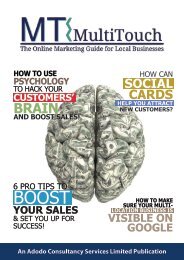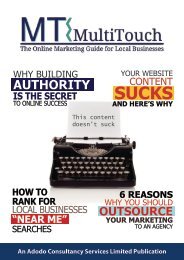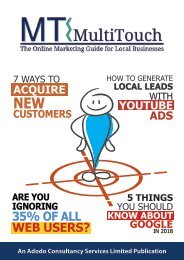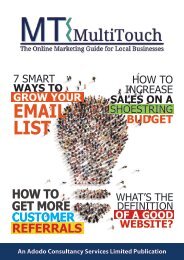mt-magazine-Jul18
You also want an ePaper? Increase the reach of your titles
YUMPU automatically turns print PDFs into web optimized ePapers that Google loves.
7<br />
TOOLS YOU<br />
PROBABLY HAVEN’T<br />
HEARD OF<br />
(That Can Boost<br />
Your Business)<br />
10 KILLER<br />
LOCAL<br />
MARKETING<br />
IDEAS TO<br />
TRY<br />
IS YOUR<br />
WEBSITE<br />
OPTIMIZED FOR<br />
SUCCESS?<br />
YOUR<br />
FACEBOOK<br />
MARKETING<br />
IS MISSING THE BOAT WITH<br />
GEN X, MILLENNIALS,<br />
AND GEN Z<br />
An Adodo Consultancy Services Limited Publication
Contents<br />
7 Tools You Probably Haven’t<br />
Heard Of<br />
News Flash: Your social media tools<br />
aren’t getting the job done. You might<br />
think you have the latest and greatest<br />
– and maybe your social media game<br />
is on point. But that said, I’m willing to<br />
bet that there are a few great tools that you haven’t heard about.<br />
Using them can help you take your social media marketing<br />
campaigns to a new level.<br />
Is Your Website Optimized for<br />
Success?<br />
I’m sure you already know about<br />
Search Engine Optimization, but a lot<br />
of local businesses are, quite simply,<br />
not getting the job done. They’re<br />
focusing on outdated SEO methods,<br />
or else they’ve designed their own website and missed out<br />
on some key opportunities to improve their Google rank. That<br />
stops now. In this post, I’ll walk you through the must-have<br />
optimization techniques that will help your website get the lion’s<br />
share of traffic for your keywords.<br />
10 Killer Local Marketing<br />
Ideas to Try<br />
Local marketing is a must, and it has<br />
a lot of moving parts. You’ve got to<br />
think about SEO, content marketing,<br />
social media and PPC ads – it’s a lot for<br />
anybody to handle. The real key to effective<br />
local marketing is knowing what ideas are worth pursuing<br />
and which ones aren’t. Here are 10 killer local marketing ideas<br />
that can have a serious impact on your profits.<br />
Your Facebook Marketing is<br />
Missing the Boat with Gen X,<br />
Millennials, and Gen Z<br />
03<br />
08<br />
14<br />
19<br />
You might be a Facebook marketing<br />
whiz. You’ve got targeting down, you<br />
create compelling posts to share with<br />
your followers, and you can curate content<br />
like nobody’s business. But guess<br />
what? If you’re not tailoring your content to the generation of your audience,<br />
you’re missing the boat. Wondering why? It’s because Generation<br />
X, Millennials, and Gen Z use Facebook in different ways. And<br />
that means you’ve got to know your audience and then customize<br />
your approach to ensure that you’re reaching them.<br />
Welcome To MT<br />
Thanks for checking out the latest<br />
edition of MT, your online marketing<br />
resource guide for local businesses.<br />
Each month we will be covering topics<br />
that resonate with local businesses<br />
just like yours.<br />
Our goal is simple. We want to<br />
enable you to do big things online,<br />
and it all starts by breaking down<br />
the complexities of marketing your<br />
business online.<br />
It doesn’t matter if you are just starting<br />
out, or an established business owner<br />
in your local community, you can<br />
always benefit from increasing your<br />
brand’s visibility online.<br />
To your Success,<br />
Tim Glynn<br />
CEO and head of fun<br />
MT IS BROUGHT TO YOU BY<br />
Adodo Consultancy Services, the leading<br />
small business marketing service dedicated<br />
to putting reputation marketing at the heart<br />
of a local businesses marketing strategy. We<br />
help small businesses connect with more<br />
customers online.<br />
If you want to build your business, you need<br />
to market, it’s that simple. But you can lose<br />
thousands of dollars if you don’t know what<br />
you are doing. So we urge you to take action<br />
with some of the strategies we recommend.<br />
Feel free to reach out to us at any time.
7 TOOLS YOU PROBABLY<br />
HAVEN’T HEARD OF<br />
(THAT CAN BOOST YOUR BUSINESS)<br />
A great artist may have vision and talent, but to bring a vision to life, the artist needs the<br />
right tools. That’s as true of painting as it is of marketing. And while a true artist should<br />
never blame tools for a job poorly done, the truth is that the wrong tools can have a<br />
negative impact on their work.
Your social media tools aren’t getting the job done.<br />
You might think you have the latest and greatest – and maybe your social media game<br />
is on point. But that said, I’m willing to bet that there are a few great tools that you<br />
haven’t heard about. Using them can help you take your social media marketing campaigns<br />
to a new level.<br />
So let’s dive in.<br />
#1:<br />
(THAT CAN BOOST YOUR BUSINESS)<br />
Facebook’s algorithm changes<br />
have upped the ante<br />
for business pages. It was<br />
already a challenge to get<br />
organic reach with your<br />
posts and now it’s harder<br />
than ever. Even if you post<br />
regularly, you still run the<br />
risk that your best content<br />
will disappear because it<br />
simply isn’t seen by your<br />
target audience.<br />
Meet Edgar is a social<br />
scheduling app that can<br />
rescue your disappearing<br />
posts and give them new<br />
life by re-sharing them. You<br />
may already be doing that<br />
– but here’s what’s special<br />
about Meet Edgar.<br />
It allows you to save your social media posts into a database, so they can<br />
easily be reshared – no more scrolling down your page to find a post<br />
It can pull items from your RSS feed, including blog posts, and add them to<br />
your social media library<br />
It categorizes your content to make it easy to find<br />
It reposts content automatically to ensure it is seen by your audience<br />
Meet Edgar is a paid tool that works for Facebook, Twitter, LinkedIn, Instagram,<br />
and Pinterest.
#2: Quuu<br />
Good social media management means<br />
posting a combination of original and curated<br />
content. Finding curated content to share<br />
with your audience can be time-consuming.<br />
Quuu can help.<br />
Quuu is a social media content curation tool.<br />
It will monitor the categories you choose –<br />
there are over 500 to choose from – and send<br />
you up to 6 content suggestions per day. If<br />
you opt for the Free or Amazing Plans (their<br />
words, not mine), the curated content will<br />
be posted automatically unless you delete it<br />
from the queue. Choosing the corporate plan<br />
gives you the option to approve content before<br />
it gets posted.<br />
#3:<br />
Maintaining a Twitter account for your business<br />
requires regular posting and staying on<br />
top of the trends and hashtags that are relevant<br />
to your location. Trendsmap is a tool<br />
that can help you do the latter.<br />
Trendsmap helps businesses get past the national<br />
and global hashtag and find the specific<br />
local trends and hashtags that are most<br />
likely to appeal to your followers. Users can<br />
click and zoom on a map interface to see the<br />
trending topics in any area. You can then click<br />
on a trending topic to get additional information<br />
and see what people are saying about it.<br />
They have multiple plans available starting as<br />
low as $25 per month.
#4: CANVA<br />
Visual content gets more engagement on<br />
social media than written content, and<br />
yet it can be difficult for people who aren’t<br />
designers to create the kind of visually<br />
compelling posts that will appeal to their<br />
followers.<br />
Canva is an incredibly versatile design tool<br />
that’s free – and perfect for social media.<br />
They have thousands of templates that<br />
you can choose from. You can also use<br />
their library of images, colors, and fonts to<br />
customize your posts. If you opt for their<br />
free plan you’ll need to pay for photos, but<br />
their paid plan gives you access to the full<br />
library plus additional storage and other<br />
features.<br />
#5: ADESPRESSO<br />
Facebook and Instagram advertising can<br />
help you grow your business, but it can<br />
also be time-consuming to manage. Ad<br />
Espresso injects a shot of caffeine into the<br />
proceedings and speeds up the process.<br />
AdEspresso is an ad management tool<br />
created by HootSuite. It gives users a<br />
dashboard from which they can manage<br />
all of their Facebook and Instagram ads.<br />
You can ad tags to your campaigns to<br />
make it easier to find them, shortcut the ad<br />
creation process, and even split test your<br />
campaigns to maximize your conversions.<br />
They offer a free trial period and business<br />
plans starting at $49 per month.
#6: #7:<br />
MobileMonkey<br />
One of the hardest things for any business<br />
to do is to convert a lead into a paying customer.<br />
It’s an expensive endeavor and one<br />
that requires an ongoing commitment and<br />
lead nurturing strategy.<br />
PushEngage is a tool that makes it simple<br />
to send push notifications on any browser.<br />
That means you can engage with potential<br />
customers who have abandoned a shopping<br />
cart. You’ll get automatic trigger notifications<br />
based on the triggers you specify,<br />
giving you the power to engage with users<br />
at the perfect moment to make a sale. They<br />
offer a free trial and business plans starting<br />
at $29 per month.<br />
Chatbots are the future of marketing – and<br />
the future is here. If your business isn’t using<br />
a Facebook chatbot yet, it’s time to get<br />
started.<br />
Mobile Monkey is a tool that will help you<br />
build a chatbot for Facebook Messenger in<br />
as little as five minutes. They offer an intuitive,<br />
drag-and-drop interface that means<br />
you don’t need any technical or programming<br />
experience to create a bot. They have<br />
a huge library of chatbot widgets, including<br />
images, text, and even emoji. They have a<br />
free plan as well as more comprehensive<br />
business plans starting at $42 per month.<br />
An artist is only as good as the tools they use...<br />
…and the 7 social media marketing tools I’ve listed here can help you elevate your social media<br />
game, attract new followers, and increase your profits.<br />
Getting people to engage with your social media content is a must. By giving yourself the tools you<br />
need, you can ensure that you get the engagement you need to grow your business.
Is Your Website<br />
Optimized for Success?<br />
Your Google ranking is undeniably<br />
important. In fact,<br />
research shows that more<br />
than half of Google’s traffic<br />
goes to the top three ranked<br />
websites, and approximately<br />
three-quarters of the traffic<br />
goes to sites listed on the<br />
first page of search results.<br />
How do they get on that first<br />
page?<br />
Here’s the secret:<br />
Their sites are optimized to<br />
ensure that they get there.<br />
I’m sure you already know<br />
about Search Engine Optimization,<br />
but a lot of local businesses<br />
are, quite simply, not<br />
getting the job done. They’re<br />
focusing on outdated SEO<br />
methods, or else they’ve designed<br />
their own websites<br />
and missed out on some key<br />
opportunities to improve their<br />
Google rank.<br />
That stops now. In this post,<br />
I’ll walk you through the musthave<br />
optimization techniques<br />
that will help your website get<br />
the lion’s share of traffic for<br />
your keywords.
Coding Tips for<br />
Optimization<br />
You’re probably not an<br />
expert programmer, but<br />
with today’s easy-to-use<br />
site-building tools, you<br />
don’t need to be. However,<br />
that doesn’t mean that<br />
you can afford to ignore<br />
some basic coding issues<br />
on your website.<br />
Metadata<br />
<br />
Metadata is the first coding<br />
issue to address. Metadata<br />
includes two things: your title<br />
tag and meta description.<br />
Both items appear on Google’s<br />
SERP, so you need to<br />
get them right.<br />
Let’s start with the title tag.<br />
Ideally, you want as much<br />
of your title as possible to<br />
appear on Google. If you<br />
shoot for a title tag that’s<br />
fewer than 60 characters.<br />
(Technically, it’s 600 pixels<br />
but that’s a little harder to<br />
measure.)<br />
Your title tag should contain<br />
your most important keyword<br />
as close as possible to<br />
the beginning of the title. After<br />
that, think about your audience<br />
and write a title that’s<br />
likely to appeal to them.<br />
The meta description is longer,<br />
usually about 155 characters<br />
including spaces. Its<br />
job is to provide a concise<br />
and compelling description<br />
of your page. It’s important<br />
to have a unique meta description<br />
for each page of<br />
your website, including blog<br />
entries.<br />
Here again, use important<br />
keywords but don’t overdo<br />
it. You want to give readers a<br />
clear idea of what your page<br />
is about to make them want<br />
to choose your site over the<br />
others that are available.
Schema Markup<br />
»»<br />
A web ID that represents<br />
a user<br />
»»<br />
The animated series<br />
Avatar: The Last<br />
Airbender or the film of<br />
the same name<br />
»»<br />
The James Cameron<br />
film Avatar<br />
Next, you’ll want to make<br />
sure to include Schema<br />
markup on your site. Schema<br />
is a collaborative effort by<br />
Google, Yahoo, Microsoft,<br />
and Yandex. It’s designed to<br />
let search engines (and users)<br />
know what your website is all<br />
about.<br />
For example, a reference to the<br />
word “avatar” might refer to:<br />
Schema code provides context<br />
for the language you use<br />
on your site. Using it properly<br />
will ensure that your site displays<br />
properly and that the<br />
information you put on it can<br />
be understood.
Crawlability<br />
<br />
The final coding issue to consider is the<br />
crawlability of your site. Google and<br />
other search engines send out bots to<br />
“crawl” your site – meaning that they<br />
check its navigability. Broken links and<br />
other issues can make it difficult or<br />
impossible for search engines to index<br />
your site properly and that can affect<br />
your search rank.<br />
You can manually check your site and<br />
make sure to repair or remove broken<br />
links. You may also want to use a tool<br />
like RankSider to check your site’s<br />
crawlability.
Your Site’s Content and Optimization<br />
When it comes to getting to<br />
the top of Google, your site’s<br />
structure and content has<br />
a lot to do with where you<br />
end up. While you can design<br />
your site to your liking, there<br />
are certain things you need<br />
to have if you want your site<br />
to do well.<br />
Global headers and footers<br />
will ensure that whatever page<br />
a user lands on, they’ll be able<br />
to find your home page and<br />
get basic information about<br />
your company. Your headers<br />
and footers should include<br />
basic information like your<br />
phone number, email address,<br />
and social follow buttons.<br />
The footer should also have<br />
hotlinks to the most important<br />
pages on your site.<br />
The About Us page may not<br />
contain a ton of keywords,<br />
but your site needs to have an<br />
awesome one to let people<br />
know who you are and what<br />
you do.<br />
The Contact Us page should<br />
let people know all the ways<br />
they can get in touch with<br />
you. That means you’ll need to<br />
include your address, phone<br />
number, email address, social<br />
pages, and directions to your<br />
office or store.<br />
Each service you provide<br />
should be on a dedicated<br />
page. Putting all your services<br />
on one page limits your SEO<br />
impact. You can target more<br />
keywords, both in your content<br />
and your metadata, if you give<br />
each service its own page.<br />
Finally, your site MUST be<br />
mobile-friendly. Ideally, you<br />
should use a template that’s<br />
mobile responsive and will<br />
adjust itself to display on any<br />
mobile device.<br />
Including these five things on<br />
your site will maximize your<br />
SEO and ensure that Google’s<br />
algorithms give you the rank<br />
you deserve.
Web Design and Content<br />
The design of your website<br />
might not play a direct role<br />
in SEO, but people will be<br />
more likely to visit (and revisit)<br />
your site if it looks good. That<br />
means that you’ll need to<br />
have:<br />
»»<br />
A simple but memorable<br />
logo.<br />
»»<br />
Compelling images that let<br />
people know what you do<br />
(and how you do it). Ideally,<br />
you should have original<br />
(not stock) images.<br />
»»<br />
High-quality video.<br />
»»<br />
Compelling written content<br />
that sounds natural, has a<br />
high degree of readability,<br />
and uses keywords and<br />
LSI artfully. You don’t want<br />
your content to be overly<br />
repetitive. It should be easy<br />
to read and use plenty of<br />
white space.<br />
»»<br />
Social share buttons make<br />
it easy for visitors to your<br />
site to share your content<br />
with their followers.<br />
»»<br />
A click-to-call button is ideal<br />
if you want to make it<br />
simple for mobile customers<br />
to call you.<br />
»»<br />
Reviews and testimonials<br />
are important. Having a live<br />
feed of your Yelp reviews<br />
might slow down your site,<br />
but you can put links to your<br />
pages on key review sites on<br />
your testimonial page.<br />
Some companies add<br />
additional bells and whistles,<br />
but you don’t need to – and<br />
your site’s loading speed<br />
may be impacted by extras.<br />
Keeping it simple is the best<br />
way to attract traffic and<br />
engage the people who visit<br />
your site.<br />
SEO is about more than<br />
keywords…<br />
Your site may have qualities and<br />
pages that we haven’t listed<br />
here, but these are the basics.<br />
Doing a quick audit of your site<br />
can reveal opportunities for improvement<br />
– and make a big difference<br />
in your Google placement<br />
and conversions.
10 KILLER LOCAL MARKETING<br />
IDEAS TO TRY<br />
Local marketing is a must, but if you’re like<br />
most local business owners, you’ve probably<br />
caught yourself thinking something like this:<br />
I feel like I’m doing everything I can – why<br />
is my local marketing not delivering the<br />
results I want?<br />
It’s a good question. After all, local marketing<br />
has a lot of moving parts. You’ve<br />
got to think about SEO, content marketing,<br />
social media and PPC ads – it’s a lot<br />
for anybody to handle.<br />
The real key to effective local marketing<br />
is knowing what ideas are worth pursuing<br />
and which ones aren’t. Here are 10<br />
killer local marketing ideas that can have<br />
a serious impact on your profits.
#1:<br />
MASTER THE ART OF LOCATIONAL<br />
MARKETING ON FACEBOOK<br />
You should always be marketing your business to<br />
your local audience on Facebook. Increasingly, consumers<br />
are turning to Facebook for information<br />
about businesses. There are two types of ads that<br />
can help you:<br />
Brand awareness<br />
Website clicks<br />
Starting with brand awareness can help you break down barriers and prime your local audience<br />
to visit you. Following up with a website click promotion will capitalize on your brand awareness<br />
campaign and help you attract new customers.<br />
#2:<br />
REVISIT YOUR YELP CATEGORIES<br />
You know that reviews are important – and Yelp has a<br />
huge SEO advantage. One of the best ways to boost your<br />
visibility online is to make sure that you’re using the right<br />
categories on Yelp.<br />
A lot of local businesses choose their categories without giving them much thought. Go back and<br />
look at them – and keep your most important keywords in mind. Choose categories that highlight<br />
your capabilities and keywords and you’ll get more organic traffic from Google.<br />
#3:<br />
BUILD UNIQUE LANDING PAGES<br />
FOR EVERY CAMPAIGN<br />
It might seem like a lot of<br />
work to build a unique landing<br />
page for every marketing<br />
campaign you run, but you<br />
can do it quickly using a tool<br />
like Unbounce. The benefit is<br />
that you’ll be sure that every<br />
click you get on an ad will lead<br />
people to a page that’s selling<br />
exactly what you’re advertising.<br />
Conversion is an art and a science.<br />
The easier it is for people<br />
to draw a line between your<br />
ad and your call to action, the<br />
higher the chances that they’ll<br />
convert. Make it simple and<br />
you’ll see an increase in sales<br />
as a result.
#4:<br />
USE REMARKETING ADS TO<br />
GET REVIEWS<br />
A huge majority of consumers<br />
rely on reviews to make buying<br />
decisions. The trick is getting<br />
your existing customers to review<br />
your business.<br />
One way to do it is to set up<br />
a simple remarketing ad for<br />
people who buy from you or<br />
fill out a form on your website.<br />
Try a headline that says, “Happy<br />
with your purchase? Leave us<br />
a review on Google+, Yelp, or<br />
Facebook!” Not every customer<br />
will respond – but some will,<br />
and every positive review you<br />
get will help increase your visibility<br />
and credibility.<br />
#5:<br />
CREATE GUIDES FOR LOCAL<br />
ACTIVITIES RELATED TO YOUR BRAND<br />
Local marketing is all about<br />
embracing where you are –<br />
and helping your customers to<br />
do the same thing. For that reason,<br />
it makes sense to create a<br />
local guide for an activity that<br />
is likely to appeal to your target<br />
audience.<br />
For example, if you sell cooking<br />
equipment, you might create<br />
a guide to local farms. Or, you<br />
could create a guide to hiking<br />
trails if you sell outdoor equipment.<br />
The key is to marry your<br />
local knowledge to your brand<br />
to give your followers something<br />
they can use.
#6:<br />
AUTOMATE RESPONSES TO YOUR TWITTER MENTIONS<br />
Social mentions can have a big impact on<br />
how your brand is perceived. One way<br />
to maximize that impact is to automate<br />
responses to your mentions on Twitter.<br />
A tool I like is Zapier, which allows business owners to set up triggers<br />
that send out instant responses when someone mentions their<br />
company. It gives an instant boost to your engagement and<br />
makes the people who mention you feel valued.<br />
#7:<br />
USE THIRD-PERSON AD COPY<br />
Sometimes, online advertising<br />
can seem like a relentless wall<br />
of noise. Everybody – including<br />
your competitors – is out there<br />
shouting about how wonderful<br />
they are. If you want to<br />
get through to your audience,<br />
you’ve got to stand out.<br />
One way to do it is to use a<br />
third-person voice in your ads.<br />
For example, you might pull a<br />
line from a testimonial and use<br />
it as your headline. “Hiring ABC<br />
Company is the best choice I<br />
ever made” is a headline that<br />
will grab attention and use the<br />
power of social proof to bring<br />
you leads.<br />
#8:<br />
USE RADIUS LOCATION<br />
TARGETING ON ADWORDS<br />
Targeting your ads on Google<br />
AdWords is really an art form.<br />
By using their radius location<br />
targeting, you can maximize<br />
the chances that your ad will<br />
be seen by the people who are<br />
most likely to buy from you.<br />
In AdWords, set up a series of<br />
radius targets so that your store<br />
looks like the center of a bullseye.<br />
Then, evaluate your data<br />
and adjust your local bids accordingly.<br />
Doing this can make<br />
a huge difference in your ads’<br />
performance.
#9: MENTION THE DISTANCE TO<br />
YOUR STORE IN MOBILE ADS<br />
The chances are good that more people are<br />
seeing your ads on mobile devices than on<br />
computers. Since that’s the case, it makes<br />
sense to play up your local connection by<br />
including the distance from your store in<br />
your mobile ads on Google.<br />
It’s easy to do. Simply use the Google Search<br />
Console to find new ad groups in your area.<br />
Then, add your zip code to your headline<br />
and see how easy it is to steal clicks from<br />
your competitors.<br />
#10: ADD STOREFRONT<br />
PICTURES TO YOUR ADS<br />
As a consumer, you’ve probably driven by<br />
local businesses many times without going<br />
inside. One easy way to entice people to<br />
come see you is to add a photograph of the<br />
front of your store to your ads.<br />
Seeing a photo will trigger a, “Hey, I’ve seen<br />
that place!” response from your audience.<br />
It’s a simple, inexpensive trick that can entice<br />
people to stop and visit you instead of<br />
driving past.<br />
DON’T WASTE YOUR TIME ON IDEAS THAT DON’T WORK…<br />
Stop guessing which marketing ideas are worth trying. These 10 simple<br />
local marketing tricks can make a huge difference when it comes to attracting<br />
customers and growing your business.
Your Facebook Marketing is<br />
Missing the Boat with Gen X,<br />
Millennials, and Gen Z<br />
(and here’s what to do about it!)<br />
You might be a Facebook<br />
marketing whiz. You’ve<br />
got targeting down, you<br />
create compelling posts<br />
to share with your followers,<br />
and you can curate<br />
content like nobody’s<br />
business. But guess what?<br />
If you’re not tailoring your<br />
content to the generation<br />
of your audience, you’re<br />
missing the boat.<br />
Wondering why? It’s because<br />
members of Generation<br />
X, Millennials, and<br />
Gen Z use Facebook in<br />
different ways. There’s no<br />
one approach that will<br />
work for all of them. That<br />
means you’ve got to know<br />
your audience and then<br />
customize your approach<br />
to ensure that you’re reaching<br />
them.
Marketing to Generation X<br />
Let’s start with Generation<br />
X. The people in Gen X were<br />
born between the mid-<br />
1960s and the late 1970s.<br />
They’re sometimes referred<br />
to as the Latchkey Generation<br />
and they’re sandwiched<br />
between the Baby Boomers<br />
and Millennials.<br />
Nearly two-thirds of Gen<br />
Xers say that Facebook is<br />
their preferred social media<br />
site. Just about half of<br />
them follow brands on social<br />
media, and following<br />
a brand is a precursor to<br />
making a purchase. That<br />
means that your Gen X followers<br />
are primed to buy.<br />
You just need to give them<br />
a reason to do it.<br />
The key is knowing why<br />
they follow you. 58% of<br />
Gen Xers follow brands<br />
because they want to get<br />
information about sales<br />
and promotions. In other<br />
words, if part of your target<br />
audience is in Generation<br />
X, you can engage them by<br />
offering them special deals,<br />
coupons, and promotions.<br />
What does that mean in<br />
practical terms? You can<br />
target your Facebook promotions<br />
by age, so you<br />
might run an ad with a coupon<br />
and target it to people<br />
in your area between the<br />
ages of 39 and 53. You can<br />
add additional targeting options<br />
based on your audience’s<br />
interests, as well.<br />
Generation X has a huge<br />
amount of buying power.<br />
They’re gainfully employed<br />
and doing well – but that<br />
doesn’t mean that they<br />
want to spend more than<br />
they need to. Keep that in<br />
mind when you’re marketing<br />
to them.
Marketing to Millennials<br />
Millennials are a different breed than<br />
Gen Xers. Millennials were born between<br />
1980 and the late 1990s/early 2000s. In<br />
other words, they’re between the ages<br />
of 18 and 38. Facebook is still their mostused<br />
social site, but they also spend a lot<br />
of time on Instagram and Snapchat.<br />
Millennials are the first generation of digital<br />
natives, which means they’ve seen it all<br />
when it comes to online content. They’re<br />
far more likely to share viral content like<br />
memes and GIFs than Gen Xers are. Millennials<br />
want to be entertained, so the<br />
content you create should be informative<br />
and entertaining. Examples might be<br />
how-to videos, behind the scenes tours,<br />
and things of that nature.<br />
The most important defining characteristic<br />
of Millennials when it comes to marketing<br />
is that they are inherently distrustful<br />
of content that’s created by brands and of<br />
sponsored content in general. They’re far<br />
more likely to put their trust in user-generated<br />
content (UGC) and online reviews<br />
than on anything you say about yourself.<br />
The solution is to encourage your followers<br />
to create content on your behalf.<br />
A good example is Starbucks’ White Cup<br />
campaign on Instagram, which asked<br />
followers to decorate plain white cups<br />
and post pictures of them. They had to<br />
use Starbucks’ special tag to enter the<br />
contest, which gave Starbucks the opportunity<br />
to share that content with its<br />
followers.<br />
Here again, it’s a good idea to create a<br />
targeted ad campaign that is directed<br />
at Millennials. By choosing the right<br />
content to promote or making an<br />
ad that will appeal to your Millennial<br />
followers, you’ll increase your chances<br />
of reaching them. It’s also a good idea to<br />
time your Millennial-targeted posts for<br />
when they’re most likely to be online:<br />
between 8 PM and midnight.<br />
Keep in mind that Millennials now make<br />
up the majority of the work force in the<br />
United States and have a ton of buying<br />
power. You should allocate your Facebook<br />
advertising budget accordingly.
Marketing to Generation Z<br />
Generation Z is the generation<br />
of young people born<br />
between the mid-1990s and<br />
the mid-2000s, although<br />
there’s some disagreement<br />
about the start and end<br />
years. There’s some overlap<br />
with Millennials.<br />
When it comes to social<br />
media use, Gen Z has a lot<br />
in common with Millennials.<br />
They use Facebook but also<br />
spend a lot of time on Instagram<br />
and Snapchat. Where<br />
they differ is in the type of<br />
content they prefer to see.<br />
The first thing you need to<br />
know about Gen Z is that<br />
their attention spans are<br />
notoriously short. Where<br />
Millennials might watch a<br />
long video, Gen Z is more<br />
likely to engage if your video<br />
content appeals to them instantly<br />
– in about 8 seconds<br />
or less.<br />
Another key concern of<br />
Generation Z is community<br />
involvement and charity<br />
work. While this issue has<br />
been a focus of articles<br />
about marketing to Millennials,<br />
it’s even more important<br />
when marketing to Gen<br />
Z. These are young people<br />
who want to use social<br />
media to change the world<br />
– and they want to support<br />
businesses that take a real<br />
interest in helping others.<br />
You can reach Gen Z by<br />
creating short, snappy videos<br />
with relatable actors in<br />
them. You don’t want anybody<br />
who seems phony.<br />
Filming your staff wrapping<br />
up donations for a local<br />
non-profit would be a great<br />
way to engage with them.<br />
Likewise, flash sales and<br />
things that require immediate<br />
action can help you grab<br />
their attention.<br />
Keep in mind that Gen Z<br />
is still young – but they’re<br />
the up-an-coming generation.<br />
Right now they might<br />
be spending their parents’<br />
money, but in a few years<br />
they’ll have their own. If you<br />
can hook them now, you’ll<br />
be in great shape when they<br />
come of age.
Targeting your ads by age might seem like a lot of work…<br />
… but it doesn’t necessarily require you to spend more money than you already<br />
are. Understanding generational differences – and providing the kind of content<br />
that will appeal to your customers of every age – will maximize the chances that<br />
you’ll be able to convert followers into paying customers.
IS YOUR BUSINESS BARELY SURVIVING<br />
OR THRIVING ONLINE?<br />
Your customers are out there, and we want to help them find you!<br />
WE CAN HELP YOU WITH:<br />
Local Search | Social Media | Website Revamps | Consulting | & So Much More!<br />
Mention THIS Ad and receive a FREE strategy session (Valued at $199)<br />
We’ll show you what you’re doing right, what you’re doing wrong, and how to boost<br />
your sales no matter what your current situation.<br />
Call or Click Today! 0115 9701471 | WWW.ADODO.CO.UK


